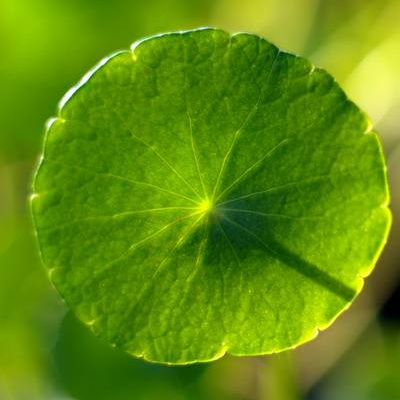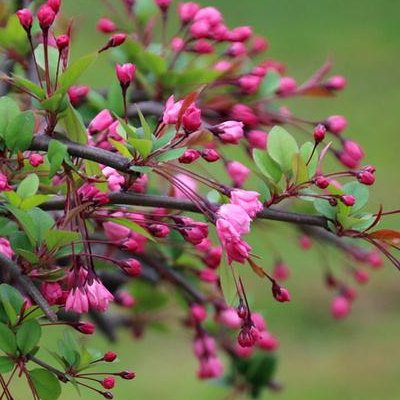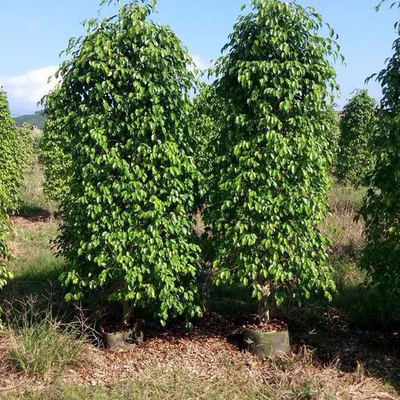The difference between hydroponic culture and soil culture of Rabdosia angustifolia
Copper money grass, this is a lot of people like breeding, this copper money grass is so likeable, how to change hydroponic culture into soil culture? What are the differences between copper money grass and money grass:

How to change water culture into soil culture of Tongqian grass:
When hydroponically cultivated copper grass is transferred into the soil, do not water it from the beginning of transplanting, wait for the water in the container to basically dry, and then plant it into the soil. You must keep the soil moist a few days ago, and gradually restore the amount of water after 3 days.
Copper grass is relatively easy to feed, but also a symbol of wealth, many people like to raise at home. The cultivation of Rabdosia angustifolia is mainly hydroponic and soil culture, hydroponics is relatively simple, so many people tend to hydroponics.
Rabdosia angustifolia prefers to grow in the shade, but occasional sunlight can promote it. The soil requires that the cultivated soil with good drainage is better, and it can survive well in a humid or less dry environment. The suitable temperature for the growth of Rabdosia angustifolia is about 22 degrees Celsius. If the soil does not have professional cultivation soil, then you can use vegetable garden soil to cooperate with river sand.
The roots of Rabdosia angustifolia can not be planted too deep, it is generally recommended that the rhizome should be covered, keep it dry in winter and minimize the moisture in the soil.
In the daily environment, the sun exposure, the general choice of time for half a day, summer flowers can be completely overcast, usually can choose half-day sunshine. The watered flowers can keep the pot soil moist every day.
Copper grass usually blossoms around July, so it is recommended that appropriate amount of organic fertilizer should be added before this, and timely fertilizer should also be added after flower fade.
When hydroponically cultivated copper grass is transferred into the soil, do not water it from the beginning of transplanting, wait for the water in the container to basically dry, and then plant it into the soil. You must keep the soil moist a few days ago, and gradually restore the amount of water after 3 days!
The difference between copper money grass and money grass:
The first thing to look at is the appearance. Although the leaves of Artemisia angustifolia are similar to those of Rabdosia angustifolia, they are all round. However, there are still some subtle differences between the two. Copper grass is just like its name, very similar to copper money. Moreover, the flowers of Artemisia angustifolia are yellow and the flowers of Codonopsis pilosula are white. During the flowering period, it is believed that the two plants can be easily distinguished by using this characteristic. In addition, it can also be distinguished from the different places where the two plants grow. Money grass will grow where the land is moderately suitable, but it will not grow by the water. On the other hand, Tongqian grass is just the opposite. Tongqian grass likes water, and what must be found at the edge of the water must be copper money grass. Therefore, the cultivation of money grass needs soil, and copper money grass can even grow directly in the water, without soil.
In addition to the difference in appearance and place of growth, it is also important to note the use of these two plants in the medical field. Codonopsis grossedentata is only an ornamental plant growing in water, while it has not only ornamental value, but also medical value. Artemisia angustifolia can be used to treat diseases such as hepatitis and kidney stones. In addition, Chimonanthus chinensis has a certain preventive effect on stone diseases. Therefore, Artemisia angustifolia belongs to a kind of medicinal material with great medicinal value.
Rabdosia angustifolia not only has no medical value, but also has trace toxicity. If Tongqian grass is mistaken for money grass, not only can not achieve the therapeutic effect, but also there may be poisoning. Therefore, we must be careful when distinguishing between copper grass and money grass.
This is the end of the method of hydroponic cultivation and soil culture. Attention should be paid to the distinction between Codonopsis lanceolata and Codonopsis lanceolata, which is poisonous.
How to hydroponically cultivate Rabdosia angustifolia
Copper grass, leaves round shield-shaped, such as a copper coin, with a long handle, wavy edge, summer and autumn small yellow-green flowers. The cultivation and management of Tongqian grass is simple, the plant shape is beautiful, the leaf color is green, and it is very durable. It is one of the most popular aquatic plants among flower friends at present, and is widely respected. This kind of plant can be potted on open ground in warm areas, and it is suitable for indoor water greening in water trays, aquariums, ponds, and wetlands. But how is it better to cultivate such copper grass?. Rabdosia angustifolia can also be hydroponized, so how to carry out hydroponics? What is the method of hydroponics? Next, I would like to tell you about the hydroponic culture method of Codonopsis lanceolata. I hope it can help you.
Hydroponic culture method of Rabdosia angustifolia
1. If you choose some copper grass, you must bring roots, or you can't live. In order to be beautiful, you can sort out its leaves according to your own preferences. Put the finished copper grass in a water culture bottle.
2. Put pebbles on the root of Tongqian grass, the pebbles are more white and look better, if there are colored pebbles bought online, then add some water, it's as simple as that.
3. Another way is to plant Codonopsis lanceolata directly into the sand. Instead of putting stones, you can only plant one or two ups and downs. It will look better when it sprouts slowly, and there is a feeling of coming out of the mud without being stained.
4. There are few diseases and insect pests. Strong growth adaptability, no need for deliberate nursing. After growing for a period of time, coriander will fill the whole container. Often spray water on the leaves to clean the leaves to keep them green and shiny. Attention should be paid to ventilation and ventilation after dense growth, otherwise the plant is prone to yellowing. The roots have been frostbitten in winter. Eager to leave the room in spring, copper grass was unable to adapt to the abrupt climate for a while. Keep it in poor ventilation for a long time. The leaf surface is not cleaned with water for a long time, which accumulates dust and hinders photosynthesis.
Key points for the maintenance of Tongqian grass
Water money is suitable for extensive cultivation, as long as it is given enough sunshine and water, it can grow very fast. Water needs to precipitate tap water for more than two hours, or use it every other day. You can add a little nutrient solution to the water. If there is no sunshine indoors, lights can be used instead. Water money generally has yellow leaves, but its withering rate is far less than the growth rate, so don't worry. The root system of water money grows green algae, but can not be cleaned. Water is not rotten, just add water to it and spray some water on the leaves at the same time.
The meaning of copper grass
According to Chinese culture, pay attention to moral meaning, homophonic, etc., copper grass, round leaves, like mini lotus leaves, quite lovely, but also like ancient copper money, meaning reunion, good luck, and the name is stained with the word "copper" and "money", the meaning is naturally different, the family has copper money, rolling sources of money, so it is regarded as a symbol of wealth, so planting copper grass in the home has both symbolic significance. It also avoids the vulgarity of decorating with golden copper coins, but the shape of copper grass is special and expensive.
The collocation of copper grass and household style
Now people have begun to shift from complexity to the pursuit of a simple and comfortable home style environment, so more and more people make the furniture style simple and chic, fresh and beautiful, and copper grass is also a variety of green plants in the home style collocation. For example, the cultivation of copper grass with round transparent glass containers, not only show fresh and beautiful, but also show personality, will let your home add a lot of artistic flavor. If it is a return to the natural pastoral home style, not to mention, copper thread grass do not lead to green, more natural and fresh and refined.
The above is the method of hydroponic culture of Rabdosia angustifolia. Are we clear? Please pay attention to more knowledge of home decoration.
The method of hydroponic culture of Rabdosia angustifolia how to hydroponic culture
Copper money grass is also known as South American coriander, coin grass, round coin grass, shield leaf day coriander, money lotus, etc., like wet environmental conditions, suitable for aquarium, aquarium, pool or wetland growth, lax environmental requirements, better in a humid environment, suitable for aquatic, light direction growth, easy crown, long, let's take a look at how to aquaculture!
Can Rabdosia angustifolia be cultured in water?
Tongqian grass can be cultured in water. Tongqian grass likes to be warm and humid, it is better to cultivate in half-day sunshine or shade, avoid direct sunlight, regardless of cultivation soil, it is better to cultivate soil with good soft drainage, or directly cultivated with water, the optimum water temperature is 22-28 degrees. Shade-tolerant, moisture-tolerant, slightly drought-tolerant, strong adaptability, strong nature, easy to plant, rapid reproduction, amphibious. Tongqian grass is afraid of the cold. If you put it outside in winter, you can pour out all the water. If you put it in a place facing south and leeward, you can survive the winter safely, but some of the leaves will die, and the underground roots will sprout again next spring. If there is no heating in the cold areas of the north, you can make a cover with a basin, pour out the water and keep it moist. As long as the room temperature is not below zero, it will continue to grow in the coming year.
The method of water culture of Rabdosia angustifolia
1. Water quality: Codonopsis lanceolata does not have high requirements for hydroponic quality, as long as it does not cause smelly insects, it can be hydroponically cultured directly with ordinary tap water. Change the water every 3-4 days in summer, half of the basin at a time, and 1/3 a week in winter.
3. Temperature: Rabdosia angustifolia is suitable for production in most hot and humid areas of the south, especially in summer. Its normal growth temperature is between 10 and 26 degrees Celsius, and overheating or overcooling will inhibit the growth of Rabdosia angustifolia.
3.Illumination: Codonopsis lanceolata is extremely fond of sunlight when it grows, so it is best to put the basin outside or by the window where there is plenty of light. If cultivated indoors, the daily sun exposure time should not be less than 4: 5 hours. In addition, ultraviolet lights or bright fluorescent lamps can also be used instead of sunlight.
4. Fertilization: Rabdosia mandshurica can produce the necessary nutrients for growth through its own photosynthesis, so it can fertilize less. If you need to apply fertilizer, you can use ordinary chemical fertilizer water to dissolve in the water basin, let it absorb itself, but pay attention to the amount is not too strong, a small amount can be.
5. Insect pests: copper grass generally does not attract insect pests, but molluscs such as water snails may gnaw on grass roots and buds. If such insects are found in the water, they should be removed by hand to prevent them from reproducing in large numbers.
Matters needing attention in hydroponic culture of Rabdosia angustifolia
1. There is no need to change the water very frequently. Under the premise that there is enough water in the basin, you can change it once a week. If you can change water more frequently in summer, it is mainly to prevent mosquitoes from laying eggs in it.
2. Keep enough light and receive more than 4 hours of sunlight every day before the grass can grow luxuriantly and verdant. Rabdosia angustifolia is particularly fond of the sun and can grow rapidly even if it does not release fertilizer in sufficient sunlight. On the other hand, if the light is insufficient or kept in a dark room for a long time, its leaves will easily turn yellow and wither.
3. There is no need to pay much attention to fertilization. If you have goldfish at home, you can pour the water from the goldfish into the basin, which can make the goldfish grow better.
4. In the south, if you grow well in the temperature range of 16-24 ℃, you can survive naturally. However, too high or too low temperature will inhibit the growth of Rabdosia angustifolia, and bugs are more likely to sprout in the water at high temperatures.
5. When the water raises Codonopsis lanceolata, the yellowing leaves will rot in the water and spoil the water quality, so we should check the water tank regularly and find that the moldy leaves should be pulled out as soon as possible.
6. The vigorous growth of Rabdosia angustifolia can spread all over the water basin in a month, so we should prune and branch it properly and transplant the overdense Rabdosia angustifolia to other water basins, so as not to block the light of the young leaves and affect the normal metabolism of plants.
- Prev

Cutting method of crabapple flower when does potted plant blossom
Crabapple flower, this is super many people like, good-looking, especially when blooming, is a string, what is the cutting method of crabapple flower? Potted crabapple flower when to bloom: begonia flower cutting method: (1) cutting time. Family cutting should be between April and May.
- Next

The difference between the culture method of weeping leaf banyan and small leaf banyan
Weeping leaf banyan, this kind of plant is generally foliage plant, or many people like it very much. What is the culture method of drooping leaf banyan? What are the differences between weeping-leaf banyan and small-leaf banyan: the culture method of weeping-leaf banyan: 1. Light and temperature: when cultivating weeping-leaf banyan, it is generally placed in a bright place.
Related
- Fuxing push coffee new agricultural production and marketing class: lack of small-scale processing plants
- Jujube rice field leisure farm deep ploughing Yilan for five years to create a space for organic food and play
- Nongyu Farm-A trial of organic papaya for brave women with advanced technology
- Four points for attention in the prevention and control of diseases and insect pests of edible fungi
- How to add nutrient solution to Edible Fungi
- Is there any good way to control edible fungus mites?
- Open Inoculation Technology of Edible Fungi
- Is there any clever way to use fertilizer for edible fungus in winter?
- What agents are used to kill the pathogens of edible fungi in the mushroom shed?
- Rapid drying of Edible Fungi

